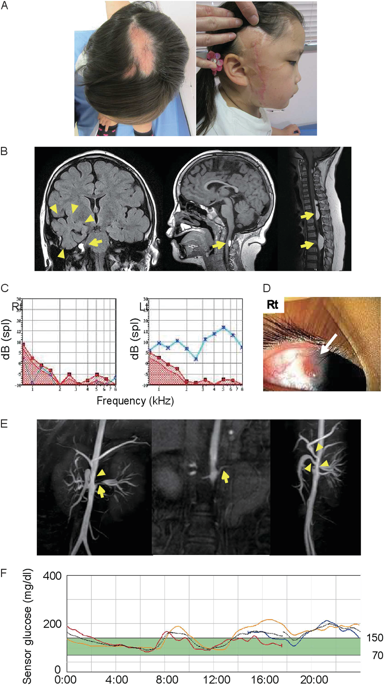当前位置:
X-MOL 学术
›
J. Hum. Genet.
›
论文详情
Our official English website, www.x-mol.net, welcomes your
feedback! (Note: you will need to create a separate account there.)
A postzygotic KRAS mutation in a patient with Schimmelpenning syndrome presenting with lipomatosis, renovascular hypertension, and diabetes mellitus.
Journal of Human Genetics ( IF 2.6 ) Pub Date : 2019-Feb-01 , DOI: 10.1038/s10038-018-0539-3 Misako Nagatsuma , Kei Takasawa , Takeru Yamauchi , Ryuichi Nakagawa , Tomoko Mizuno , Eriko Tanaka , Kouhei Yamamoto , Noriko Uemura , Kenichi Kashimada , Tomohiro Morio
Journal of Human Genetics ( IF 2.6 ) Pub Date : 2019-Feb-01 , DOI: 10.1038/s10038-018-0539-3 Misako Nagatsuma , Kei Takasawa , Takeru Yamauchi , Ryuichi Nakagawa , Tomoko Mizuno , Eriko Tanaka , Kouhei Yamamoto , Noriko Uemura , Kenichi Kashimada , Tomohiro Morio

|
Schimmelpenning syndrome is a rare neurocutaneous disorder categorized as a mosaic RASopathy due to postzygotic HRAS or KRAS mutations. We report a 6-year-old girl diagnosed with Schimmelpenning syndrome due to a postzygotic KRAS G12D mutation. The patient had three atypical symptoms of Schimmelpenning syndrome: renovascular hypertension, congenital lipomatosis, and diabetes mellitus. The first two symptoms may overlap with phenotypes of other neurocutaneous syndromes or congenital lipomatous overgrowth syndrome due to mosaic RASopathies or other somatic mosaic mutations. We propose that impaired glucose tolerance was caused by KRAS mutation and a novel clinical phenotype of Schimmelpenning syndrome. Our study indicated that clinical diagnosis of Schimmelpenning syndrome or related conditions should be reorganized with genetic diagnosis of postzygotic mutation. Moreover, further accumulation of genetically proven cases with mosaic RASopathies should be used to more accurately characterize phenotypic presentations of this syndrome and develop a future therapeutic strategy, such as molecular-targeted therapy.
中文翻译:

患有Schimmelpenning综合征的患者发生合子后KRAS突变,并伴有脂肪瘤病,肾血管性高血压和糖尿病。
Schimmelpenning综合征是一种罕见的神经皮肤疾病,归因于合子后HRAS或KRAS突变,被归类为镶嵌性RAS病。我们报告了一个6岁的女孩,由于合子后KRAS G12D突变而被诊断为Schimmelpenning综合征。该患者患有Schimmelpenning综合征的三个非典型症状:肾血管性高血压,先天性脂肪瘤和糖尿病。前两个症状可能与其他神经皮肤综合征或先天性脂瘤性过度生长综合征的表型重叠,这是由于镶嵌RASopathies或其他体细胞镶嵌突变引起的。我们建议,糖耐量受损是由KRAS突变和Schimmelpenning综合征的新型临床表型引起的。我们的研究表明,Schimmelpenning综合征或相关疾病的临床诊断应与合子后突变的遗传学诊断重新组合。此外,应进一步利用镶嵌RASopathies进行遗传学证实的病例积累,以更准确地表征该综合征的表型表现,并制定未来的治疗策略,例如分子靶向治疗。
更新日期:2019-01-26
中文翻译:

患有Schimmelpenning综合征的患者发生合子后KRAS突变,并伴有脂肪瘤病,肾血管性高血压和糖尿病。
Schimmelpenning综合征是一种罕见的神经皮肤疾病,归因于合子后HRAS或KRAS突变,被归类为镶嵌性RAS病。我们报告了一个6岁的女孩,由于合子后KRAS G12D突变而被诊断为Schimmelpenning综合征。该患者患有Schimmelpenning综合征的三个非典型症状:肾血管性高血压,先天性脂肪瘤和糖尿病。前两个症状可能与其他神经皮肤综合征或先天性脂瘤性过度生长综合征的表型重叠,这是由于镶嵌RASopathies或其他体细胞镶嵌突变引起的。我们建议,糖耐量受损是由KRAS突变和Schimmelpenning综合征的新型临床表型引起的。我们的研究表明,Schimmelpenning综合征或相关疾病的临床诊断应与合子后突变的遗传学诊断重新组合。此外,应进一步利用镶嵌RASopathies进行遗传学证实的病例积累,以更准确地表征该综合征的表型表现,并制定未来的治疗策略,例如分子靶向治疗。































 京公网安备 11010802027423号
京公网安备 11010802027423号